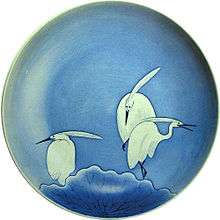Nerikomi
Nerikomi is an artistic technique for creating ceramic pottery. The name derives from a traditional Japanese technique of creating patterns with colored clay.[1]
History
Nerikomi is a contemporary Japanese term. Marbling ceramic techniques were used in Egypt and China and through the Romans to the West. Early ceramics in the Stoke-on-Trent use more than one colour of clay for decorative effect. In England this was referred to as agateware. In Japan there are a few pieces from the Momoyama period, and Edo, as well as Mingei and there was an explosion of it from about 1978–1995 due probably to Aida Yusuke's advertising and to Matsui Kousei who refers to his work as neriage.
The term started being used in the 1970s to describe related kanji Neriage. Yusuke Aida was on a television commercial for Nescafé and it seems to have entered the vocabulary at about that time when his nerikomi coffee cups were available to the first people contacting the advertisers.
It was used in the Tang Dynasty in 7th century China there are at least two Chinese characters to describe variations of this technique (one surface, one structural).[2][3]
Technique
Slabs of different clays or clays colored with stains or oxides, are stacked, folded, pressed into logs, sliced, and arranged to form a vessel. In this way, the numerous stacked layers appear as fine undulating lines embedded in a surrounding color in the finished vessel.
See also
References
External links
| ||||||||||

